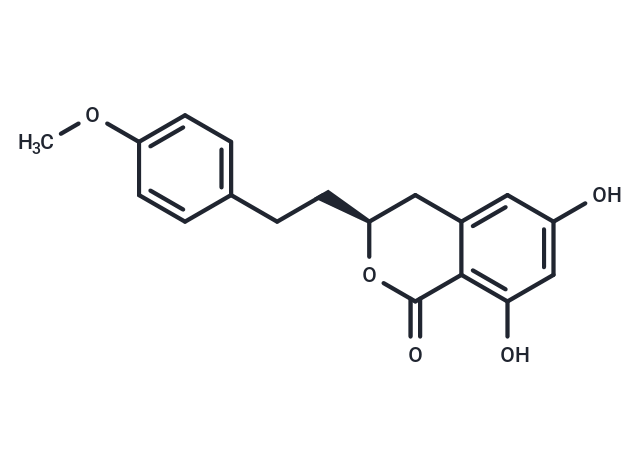- Remove All
 Your shopping cart is currently empty
Your shopping cart is currently empty
Agrimonolide
Agrimonolide, a compound derived from isocoumarins and found mainly in the herb Agrimonia pilosa Ledeb, has significant biological activity. agrimonolide exerts anti-inflammatory effects by inhibiting lipopolysaccharide (LPS)-induced activation of JAK-STATs and p38 MAPKs signaling pathways. Agrimonolide and its derivative, desmethyl agonolide, have been shown to be effective in increasing insulin-mediated glycogen levels in hepatocytes and may play a key role in regulating insulin-resistant HepG2 cells. agrimonolide exhibits inhibitory effects on cancer progression and induction of cell death and apoptosis by targeting SCD1 in ovarian cancer cells. In particular, Agrimonolide exhibited a dose-dependent inhibition of proliferation, migration and invasion of A2780 and SKOV-3 cells, while promoting apoptosis. The compound was also found to induce iron-mediated cell death while increasing reactive oxygen species (ROS) and total iron levels.Agrimonolide readily crosses the blood-brain barrier, suggesting its potential for therapeutic applications in neurological disorders.

Agrimonolide
| Pack Size | Price | Availability | Quantity |
|---|---|---|---|
| 5 mg | $1,980 | Backorder | |
| 1 mL x 10 mM (in DMSO) | $2,398 | Backorder |
Product Introduction
| Description | Agrimonolide, a compound derived from isocoumarins and found mainly in the herb Agrimonia pilosa Ledeb, has significant biological activity. agrimonolide exerts anti-inflammatory effects by inhibiting lipopolysaccharide (LPS)-induced activation of JAK-STATs and p38 MAPKs signaling pathways. Agrimonolide and its derivative, desmethyl agonolide, have been shown to be effective in increasing insulin-mediated glycogen levels in hepatocytes and may play a key role in regulating insulin-resistant HepG2 cells. agrimonolide exhibits inhibitory effects on cancer progression and induction of cell death and apoptosis by targeting SCD1 in ovarian cancer cells. In particular, Agrimonolide exhibited a dose-dependent inhibition of proliferation, migration and invasion of A2780 and SKOV-3 cells, while promoting apoptosis. The compound was also found to induce iron-mediated cell death while increasing reactive oxygen species (ROS) and total iron levels.Agrimonolide readily crosses the blood-brain barrier, suggesting its potential for therapeutic applications in neurological disorders. |
| In vitro | Five compounds were isolated from AP using column chromatography, including Agrimonolide (K1), desmethylAgrimonolide (K2), tormentic acid (K3), ursolic acid (K4), and quercetin (K5). Glucose metabolism was evaluated in insulin-resistant HepG2 cells. K1 consisting of K2 effectively increased the insulin-mediated glycogen level in hepatocytes. At a concentration level of 20 μM, K1 significantly elevated the hepatic glucokinase (GK) activity (3.0 U min-1 mg-1 protein) compared to the control. And K1 caused a significant reduction of the glucose-6-phosphatase (G6Pase) activity and a significant change in the phosphoenolpyruvate carboxykinase (PEPCK) activity. [1]
Agrimonolide dose-dependently inhibited proliferation, migration, and invasion and promoted apoptosis in A2780 and SKOV-3 cells. Agrimonolide induced ferroptosis in tumour cells, evidenced by the increased levels of ROS, total iron, and Fe2+ and downregulation of ferroptosis indicators (SLC7A11 and GPX4). Additionally, agrimonolide attenuated the tumour growth of ovarian cancer in the SKOV-3 xenograft model and significantly downregulated SCD1 in tumour tissues.[2] |
| Molecular Weight | 314.33 |
| Formula | C18H18O5 |
| Cas No. | 21499-24-1 |
| Smiles | COc1ccc(CC[C@H]2Cc3cc(O)cc(O)c3C(=O)O2)cc1 |
| Relative Density. | 1.293g/cm3 |
| Storage | store at low temperature,keep away from direct sunlight | Powder: -20°C for 3 years | In solvent: -80°C for 1 year | Shipping with blue ice. |
Calculator
In Vivo Formulation Calculator (Clear solution)
Dose Conversion
Tech Support
Keywords

Copyright © 2015-2025 TargetMol Chemicals Inc. All Rights Reserved.




